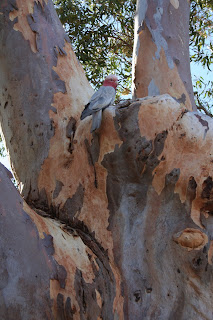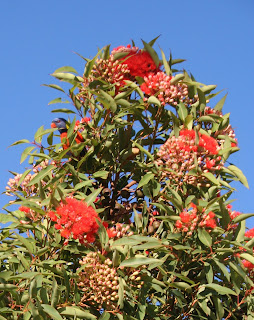Indian ringneck alert
 This pestilent, introduced, Indian Ringneck has been caught in Fremantle.
This pestilent, introduced, Indian Ringneck has been caught in Fremantle.Western Australia's agriculture and food department reminded Sandgropers not to allow birds to leave aviaries after the friendly former pet was found by a nursery man at Dawson's garden world in the light industrial area of O'Connor.
Department biosecurity officer Brett Scourse (pictured) said Dawson's staff reported the suspicious-looking bird, and helped by feeding it to keep it in the area until department staff could capture it.
The feathered subcontinental is rumoured to be a former shouldertop associate of Saddam Hussein.
"This is another reminder that Indian ringnecks are at great risk of establishing feral populations in Western Australia, if they are released or escape from aviaries," Mr Scourse said. "Escaped birds are regularly found in the wild, with reports over the past two years of birds in Belmont, Lake Monger, Hyde Park, Yangebup, Ocean Reef, St James, Stoneville, Mt Nasura, Morley, Calista, York, Cottesloe, Forrestdale and Mandurah.
"Indian Ringnecks are declared pests in Western Australia and all birds found in the wild are immediately removed," the biosecurer added. "Their pest status requires that they are kept under secure conditions indicated by a permit."
Mr Scourse said Indian ringnecks posed a significant threat to Western Australian agriculture and horticulture, with potential to damage cereal and oilseed crops, as well as stored grain [unlike our heavenly native parrots:-)].
"There are large numbers of the birds kept as pets and owners need to be vigilant and ensure they do not escape," he said. "They are required to be kept in a secure double-doored aviary at all times."
"It is also important for the public to remain vigilant and report any unusual sightings of birds in their area as soon as possible. "
The Indian ringneck is a long-tailed, grass-green parrot with a red beak, slightly smaller than a native 28 parrot. Male birds have a narrow black and pink ring around the neck, while females and immature birds sometimes have emerald rings.
Sometimes the birds may be blue, yellow and white in colour, from being bred in captivity.
Sightings of the Indian ringneck should be reported to the department on freecall 1800 084 881.
Labels: Indian ringneck








